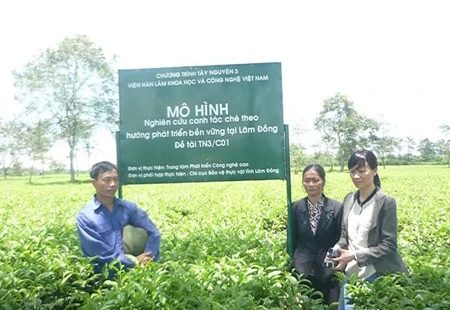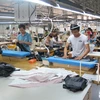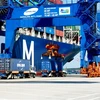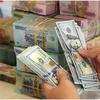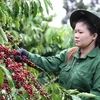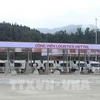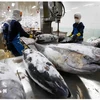Hanoi (VNA) - Vietnamese exporters of agricultural products must join global production chains if they are to take advantages of the opportunities of the Trans Pacific Partnership (TPP) free trade pact.
Opportunities are foreseen but there exist worries about the real dangers for Vietnam's agriculture from the TPP agreements.
In an article about the TPP opportunities for Vietnam on the government's website chinhphu.vn, Chairman of HCM City Food Association Van Duc Muoi said that the country has to open the market, or eliminate 100 percent of import duties for agricultural products, while it has no technical barriers or has ones which are not stringent enough.
Muoi, who is also general director of Vissan, said duties are a part of the story. The duties could be reduced or wholly eliminated but technical barriers to trade and sanitary and phytosanitary measures from other countries will be very strict on packaging, label, maximum level for pesticide residues and legal origin of materials – which may keep Vietnam out of the select group of TPP member countries.
Related to agricultural products, in facets of production, a number of commitments in TPP will directly affect domestic production as well as the potential of products in Vietnam.
He gave an example on a TPP commitment clause on child labour which prohibited the use of children and eliminated the worst forms of child labour. In Vietnam, handicraft villages would be the first vulnerable group as their products are made by households which include children.
To turn the opportunities into reality, Muoi gave an assessment on competition capacity of the Vietnamese agriculture in comparison with its TPP partners.
Brunei, Malaysia and Singapore do not pose any problem because Brunei and Singapore are small countries, and their agricultural production is insignificant, while Malaysia has been importing agricultural products from Vietnam, including rice, vegetables, fruit and meat.
Australia and New Zealand are seen as countries challenging Vietnam as they have the competitive capacity at the highest level in the world with products such as beef, milk, apple and orange.
Meanwhile, Vietnam's capacity to access the markets of the two countries is very small because their population is low. Australia has about 25 million people while New Zealand has some 5 million. In addition, their technical barriers to trade and domestic competitive capacity on agricultural products stand at the highest level in the world.
Even though the FTAs are signed, Vietnam's benefit from agricultural product exports to those two markets is almost zero while challenges are significant. Therefore, the commitment to open the market to the two countries should stand similar with the level Vietnam has committed in ASEAN-Australia-New Zealand agreement to avoid the situation to be more serious.
Peru and Chile are at quite a distance in terms of geography from Vietnam. They have a small population and their competitive capacity is similar with Vietnam.
As for the US, it has not signed any free trade agreement with Vietnam, either bilateral or multilateral, therefore Vietnam will open its market at the same level of the WTO commitment.
Vietnam has the opportunity to export vegetables and fruits to the US, however, the US has strictly applied technical barriers to trade and sanitary and phytosanitary measures so that the country's export may be limited.
The US is at an advantage shipping in very high volumes products such as milk, beef, pork and poultry, to Vietnam. If Vietnam opens the door for such products, similar products in the country will face with difficulty when competing with the US products.
In such a situation, Vietnam needs to develop an agro-product supply chain to become an important processed agro-product supplier for the world.
Speaking at a seminar on opportunities and challenges when Vietnam takes part in the FTA and TPP recently in HCM City, Deputy Minister of Agriculture and Rural Development Tran Thanh Nam, said if the country did not prepare right now, farmers would be the most vulnerable when imported goods flooded the domestic market.
"There is a need to concentrate on re-organising production, planning growing areas to ensure clean materials for domestic processors and exporters. This is the most worrying issue compared with issues on improving competitive capacity for businesses or State management capacity," Nam said.
Even in the domestic market when the TPP agreement has not come into effect, meat from TPP member countries, especially chicken from the US, has flooded the market, causing the local chicken-raising industry to face many difficulties.
According to Deputy Chairman of Vietnam Pepper Association Nguyen Mai Oanh, the TPP is an opportunity for the pepper sector to rectify its problems, in which the production chain and quality control are the biggest issues.
"The State should support the sector to associate farmers to form co-operatives which will be in the cultivable areas. From there the businesses can connect them to larger pepper growing areas," Oanh said at the conference.
Chairman of HCM City's Farm Club Luu Hong Trien, said the information on integration has reached businesses, processors and exporters but not farmers, who directly take part in raising animals. Therefore, while numerous products are available in redundance, the farmers do not know about it and continued their investment.
Integration into ASEAN, EU and TPP member countries will be a big challenge, which is not easy to surmount when most Vietnamese businesses have been exporting crude agricultural products, not strong enough to take control the market. If the country does not make changes to adapt to the situation, its agricultural market will face difficulties with regard to access to opportunities from the TPP.-VNA

